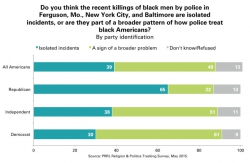May
20
2015

Written by Sean Thomas-Breitfeld
Earlier this month, a new poll revealed that there was a “deep divide” between blacks and whites on race and the criminal justice system. I’m not sure that this news was all that surprising since, as Alvin noted in his blog about the unique brand of millennial racism , there are lots of polls revealing that race is still a stark dividing line in our society. But the interesting finding in the poll was that the views of more whites had shifted over the last year to seeing the continued killings of black people by the police as part of a broader pattern, not just isolated incidents.
Much of the credit for this shift in public opinion to actually recognizing structural and systematic forces of anti-black racism must go to the protests that have followed these deaths at the hands of police officers. The chipping away at the race-blindness of people who want to ignore structural forces and claim that all experiences of racial bias are isolated shows the power of the Black Lives Matter movement, and how it is seeping into society’s consciousness.
The polling data shows how complicated changing public consciousness is. In late 2014, 60% of white Americans said that the recent killings of black men by police were isolated incidents, but 45% express this view today. That 15-point swing away from a race-blind insistence on a “just a few bad apples” narrative is huge progress, but it didn’t translate to an equal surge in white people recognizing that these killings were part of a broader pattern of behavior among police. Over the same period of time, the share of white respondents agreeing with the “broader pattern” viewpoint that leads to structural and policy reform increased by 8 points to 43%, which is roughly the same as the people holding the opposite view. The rest of the people who were peeled off from the “isolated incidents” perspective presumably now fall in the “don’t know” category but that is still major progress because getting people to recognize what they don’t know or question what they think they already do know is often the first step in changing their minds.
The fact that minds are changing should also prompt some introspection by those who have been critical of the many marches that have disrupted traffic and dominated the news over the past year; and especially the pundits who called protesters “thugs” and “rioters.” Many others have written about the racial bias with which the term “riot” is applied to cases of public unrest, but the liberal critique of rioters is often that they confuse/muddle/overshadow the message of more disciplined and peaceful protests. But the shift in public opinion by whites happened even though sometimes the line between protest and riot blurred, nonetheless the message got through.
I think the best explanation (not defense) of the power of protest – whether disciplined or chaotic – to shape public consciousness comes from a speech Martin Luther King, Jr. made half-a-year before he was assassinated. King said that the crime and looting that accompanies urban unrest must be understood as “derivative crimes” and a response to the policymakers who created discrimination, slums, unemployment and poverty. He said in that same speech that leadership requires not being a “searcher of consensus, but a molder of consensus.” Clearly, the public consensus on the issues that have motivated so many people to take to the streets is shifting. It’s great to see than the Black Lives Matter movement has both sparked a renewed spirit of activism and is changing the way people think about the racial biases at work in our nation’s criminal justice system. The movement deserves credit for molding consensus.
Image shown is from the Public Religion Research Institute Survey
